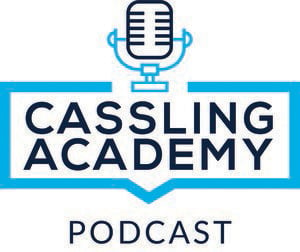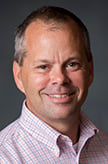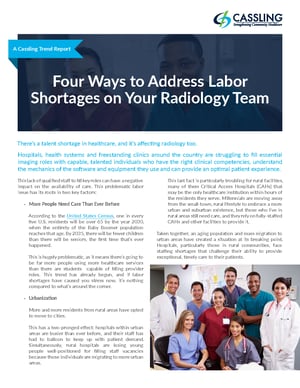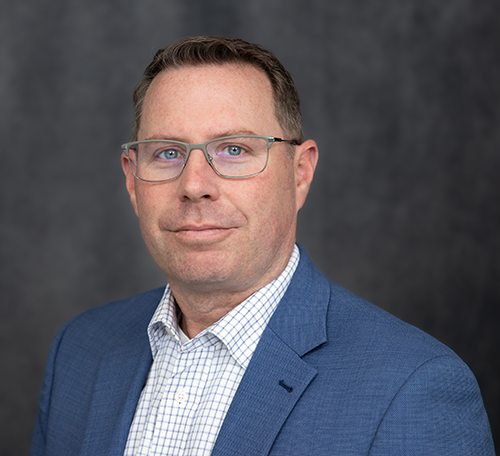LMH Health VP Addresses Patient Experience and the Future of Healthcare Leadership
by Kyle Salem, Ph.D. on May 9, 2019

Brian Bradfield, the Associate Vice President for Ancillary Services at LMH Health in Lawrence, Kansas, visited the Cassling Academy Podcast to talk to Cassling President Kyle Salem. In this wide-ranging chat, which you can read or listen to below, Brian and Kyle talk about the effect employee experience has on patient experience, how to cope with a rapidly changing healthcare landscape and what future leaders can do to succeed as a hospital or health system executive.
The following is an interview transcript edited for clarity and length. If you prefer, you can listen to the full podcast in the player below.
Kyle Salem: Welcome back to the Cassling Podcast series, I want to thank everybody for joining us again. Today we have with us Brian Bradfield. Brian is the associate vice president for ancillary services at LMH Health. Welcome Brian.
Brian Bradfield: Thanks, Kyle. I look forward to having the conversation with you today.
Kyle Salem: To get us started, why don't you tell us a little about your role at LMH Health and describe the organization from a 10,000-foot view.
Brian Bradfield: I'm the associate VP of ancillary services, which includes imaging services, respiratory therapy, pharmacy and laboratory.
LMH Health is a community hospital. We are owned by the city. We are a non-profit organization and we receive no tax money from the city. We're completely funded by ourselves. 174 beds. Our primary market here is Douglas County. We are a facility that has a college-type setting with Kansas University located in the center of the city.
Then we have some secondary markets, the outer edges of the city where we have some clinic operations. We're flanked by the capital of Topeka, as well as the Kansas City metropolitan area, so we sit between two big systems.
 Clinical Background Shapes Patient Initiatives
Clinical Background Shapes Patient Initiatives
Kyle Salem: Prior to where you are now, I know you served in a series of patient-facing positions within radiology. You were the imaging director for many years at the facility, and an MRI tech for even longer before that. How does having that patient-facing background shape your perspective and the way it brings you to work every day?
Brian Bradfield: Coming from a clinical background and facing the patients has given me some insight into the needs and expectations of the patients. ‘What are the barriers to having a successful service?’ You can get a little more intimate when there are concerns and issues that come up because you have a better and broader understanding of the problem.
You're not just taking it from a business perspective, you're taking it from a customer, consumer or patient perspective.
Kyle Salem: Can you talk about any particular wins or successes LMH has introduced that really go down that path of patient experience?
Brian Bradfield: We’ve developed a multitude of different initiatives. We have one initiative where we involved not only employees of LMH Health but also invited in previous patients to get their perspective from the outside looking in versus the inside looking out.
As you know, perception is the truth of the person who has concerns or great service, so we take a very rounded approach to how we provide service in the ways patients want.
The Future of LMH Health
Kyle Salem: If you look toward the future, what's new and what's coming for LMH Health?
Brian Bradfield: We actually have quite a bit going on right now. We're in the process of a 100 million dollar-plus project, expanding to a brand-new facility we’ll be calling LMH Health West. It's about a 240,000 square foot building that will house a multitude of outpatient services. We understand outpatient is the future of healthcare. A lot of payers are pushing in that direction, trying to be cost-effective, so we're moving into that world, looking at where our expansion and growth is within the city and where we have the ability to provide better access.
Another big push we have right now is on consumerism and looking at how we provide better care when, where, and how our customer or patients or families want it. How do we engage in risk-based payer models? We're involved right now in an ACO (Accountable Care Organization) with Blue Cross Blue Shield of about 1,800 patients. We’re evaluating how we manage that and do the right thing for our patients.
Looking at population health, as our purpose statement says, we're a partner for lifelong health, so we're looking, as is everyone else, at ‘how you keep patients out of your hospital?’ ‘How do you make sure you're offering community education and community resources?’ ‘How do you keep people healthy?’ ‘How do you engage in that?’
The Spirit of Collaboration/Labor Pains
Kyle Salem: Do you view the markets to the East [Kansas City] and West [Topeka] as competitors or do you view them as essentially potential partners where you can work together?
Brian Bradfield: We try not to approach it from a competitive standpoint. Everybody's always in competition for the patients, but we try to look at it as more of a partnership. ‘How do we collaborate?’ ‘How do we keep an open communication with what we do?’
We know we can't be the end-all, do-all for every patient. We’ve got to create partnerships and collaborations with facilities that can provide services that otherwise may not be available in Lawrence.
But with that being said, we do try to provide a pretty high-level, broad spectrum of services, from orthopedic to neurology, oncology and cardiology. For a community hospital, we have a pretty large breadth of services we can provide but, where we know we can't, we try to create those partnerships and send to those facilities we believe hold our patients' best interests.
Kyle Salem: When you come to work every day, what are some of the pain points? What are the things impacting you?
 Brian Bradfield: Right now, what we're seeing on the ancillary side is the labor force. If you look at the Kansas labor report and the Missouri labor report, ancillary service lines with med techs, pharmacy techs and radiology technologists are a real struggle right now. The turnover and vacancy rates are pretty high and the amount of people retiring is quite high as well.
Brian Bradfield: Right now, what we're seeing on the ancillary side is the labor force. If you look at the Kansas labor report and the Missouri labor report, ancillary service lines with med techs, pharmacy techs and radiology technologists are a real struggle right now. The turnover and vacancy rates are pretty high and the amount of people retiring is quite high as well.
We’re working through that while also working through how we maintain the level and quality of service in a cost-effective way without creating any issues or concerns with patients and employees.
I think it's a good balance of trying to do both, because if you sway one way or the other, then you find yourself in a pickle.
Employee Experience Translates to Patient Experience
Kyle Salem: Certainly. That plays into the next topic I wanted to move to, which is this combination of employee experience and customer experience. It's been a focus for Cassling here over the years. We believe we have an obligation to provide a great experience for our employees because that allows them to ultimately do their best work every day.
Are there things LMH Health has done to look at employee experience and how the employees interact with the organization?
Brian Bradfield: We have a couple initiatives within the organization. We kicked off a culture initiative two years ago and developed some cultural beliefs within the organization to drive our initiatives. We did training with all the staff. We implemented different types of tools to get staff to engage with one another.
When I say staff, I mean, from top to bottom, bottom to top. We actually did a four-hour training with over 1,400 employees in the organization. We do storytelling, we do focused feedback, we have recognition tools to promote a positive culture in an organization. We understand with a great culture comes great patient care.
That's been one initiative. We have a group of people, we call ourselves the Culture Club, that get together once a month to talk about different initiatives within the organization. If we identify areas or gaps, then we deploy two or three people out of that group who have been specially trained to help get a conduit to better culture within the organization. We've developed some things with a physician group. LMH has grown quite a bit on the physician side, so we want to make sure we engage our physicians as much as we engage our employees.
Kyle Salem: You mentioned the idea of employee satisfaction driving patient satisfaction. Are there specific efforts on the patient experience side that your patients can look for as what LMH Health is doing to make sure the experience is the best it can be?
Brian Bradfield: We have a lot of stuff on the exterior. We do valet parking now for patients. We involve them in decision-making as much as possible when we're making changes. We're trying to leverage technology to make things as easy as possible. We're in the process of integrating some online billing, online scheduling, appointment-making, really focusing on the consumer.
We just launched a telehealth program. We're hoping to complete that in the middle of the year. We're also engaged with understanding what are our key drivers from the patient satisfaction standpoint that we should really dial in on so we're not just shooting from the hip. We’re really trying to make it an efficient effort across the organization.
We also have an operational excellence department that goes out to different areas and helps them develop tools to monitor and improve processes, which then impacts patient experience.
Dealing with Disruption
Kyle Salem: I think you've got a lot of things going that will start to change the way patients and employees experience their interactions with LMH Health.
We talked earlier about collaboration. How do you envision collaboration with other healthcare entities, whether that be full health systems or physician groups, changing over the next five to ten years?
Brian Bradfield: LMH is one of those unique, diamond-in-the-rough community hospitals. We acknowledge and understand that, for our success and growth, we have to be collaborative with other groups. Looking even further, in the five- to ten-year range, the healthcare platform is going to change so much.
You've got Google, Apple, Amazon and Lyft, a multitude of entities trying to enter into the healthcare market who have been really successful in their fields. I think when they come into the healthcare realm, they're really going to shake things up.
One of the key pieces we need to have is some really good adaptive leadership within the organization so we can roll with those changes and be nimble.
Kyle Salem: What do you see as the keys to success in the industry for a provider? What are the things you think LMH is going to have to make sure they do to stay in front of the market?
Brian Bradfield: I think one of the first and foremost things is just being efficient and cost-effective. As reimbursements are being decreased, there's a higher chance of having these risk-based payer models. We need a good grasp of that and we can’t be reactive. We need to be proactive.
I think we're doing a pretty good job at that right now. We're doing a deep dive organizationally looking at just about everything we do just to see if there’s something we could improve. I think the other piece is always looking to the future, not looking to the past. Let’s not look at what happened, let’s look at what's going to happen.
And again, just being proactive and making changes. I think in doing our LMH Health West campus, knowing things are moving to the outpatient realm, it's going to position us well for the future. We've got some expandable space there that allows us to partner with other entities to come into the facility and provide services for us.
How to Succeed as a Future Healthcare Leader
Kyle Salem: You've seen a lot over the last 20 years, in a lot of different roles. What advice do you have for someone coming up through the leadership ranks in healthcare, someone aspiring to take on more. What is Brian Bradfield's view of things they need to be doing?
Brian Bradfield: First and foremost, you need to get comfortable being uncomfortable. Healthcare is an ever-changing field. If you're not willing to understand or take on being uncomfortable, this definitely is not a place for that type of a person.
Taking your blinders off is a real key to growth and success. It is too easy to get into your lane and stay in your lane in healthcare. Everything is converging. I remember first getting into healthcare, your focus was to come in, do an exam and go home. Now you need to learn about insurance companies and pre-authorizations. You have to get out of your comfort zone, take off your blinders, do a lot of reading, understand what's going on in the market, be proactive and not wait to be told what to do. Come up with your own initiatives.
Another piece is getting really engaged in your organization and in healthcare itself. Getting on different committees and groups. Getting out into the community to learn what their expectations are. Just being really well-rounded.
You look at healthcare now, it's such a business. It's not too easy to manage it, that's what drove me to go back and get my MBA, knowing that it's just not enough to know the clinical side, you need to know the business aspect. What goes on behind the scenes. If you stay on the front end, you really don't understand.
Small things you do can impact your organization, and understanding what those are is important.
Kyle Salem: Anything else you'd like to leave our listeners with today?
Brian Bradfield: No, I just really appreciate you taking the time to have the conversation. It's been good. Hopefully people find it insightful.
Kyle Salem: I appreciate it Brian, and I appreciate you taking time out of your busy schedule to talk with all of us listening.
Brian Bradfield: You're welcome.
Meet the Author
Kyle Salem, Ph.D.
President of Cassling
Kyle joined Cassling in February 2005 and was named President in 2017. Kyle holds a doctorate in Biomedical Engineering as well as business education through the Kellogg School of Management. Prior to Cassling, he worked with Siemens Healthcare's Magnetic Resonance Imaging division serving as a scientist and manager.
Today, Kyle strengthens community healthcare by working with customers to ensure Cassling's offerings meet their short- and long-term goals, as well as clinical, financial and organizational needs. With a focus on helping customer increase quality and decrease cost, he manages Cassling's corporate strategy, advising the organization on industry direction and trends to help intelligently drive the growth, while exploring new business opportunities.
Click
here to request more information about Cassling's Speakers Bureau or call 800-228-5462 ext. 1117.




Comments